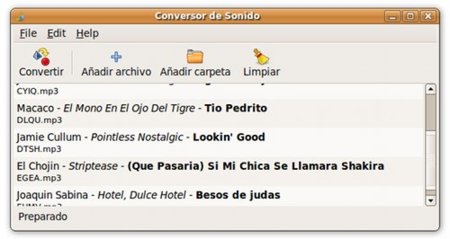

- #Soundconverter .deb how to
- #Soundconverter .deb install
- #Soundconverter .deb manual
- #Soundconverter .deb password
- #Soundconverter .deb iso
#Soundconverter .deb install
I already tried to download the folder color application but it did not install me from the terminal.
#Soundconverter .deb how to
Or at least tell them how to install an application that allows me to modify folders such as changing the horrible gray color it has. Hello, good night, I'm from Argentina I am new to Linux and I have currently installed debian 7 (very stable truth) but I have two problems that I need help to solve:ġ- I would like to change the gnome environment if possible because I don't like it, and I don't know how to do it. Then go back to / usr / share / gnome-shell and paste it, if it asks you to replace say yes. Reopen Nautilus with administrator permissions in the directory where the downloaded theme is located, and click to copy to the "theme" folder (the one you just renamed). You will see that inside the main folder of the theme there is another folder called gnome-shell, rename it to "theme". Then proceed to unzip the theme file to any directory. Choose the one you want to install and download it to your computer. Now search the web for themes for Gnome Shell, Gnome 3 or GTK3 (all are alternative names for the same thing) in Deviantart you can find several very attractive visually, if not, a simple search in Google will take you to different themes. You will see that there is a folder called theme, where the default theme is located, this folder copy it and paste it in a safe place. Which will open the Nautilus manager in the / usr / share / gnome-shell directory, which is where you will always find everything regarding the Gnome 3 settings for your user account. To switch between different managers, we just have to type in a terminal: Now we can configure it to our liking with the input window tool from the menu-system tools-administration. When finished, we restart and we will have the new login screen. During the installation it will ask us which manager we want to activate among those that we have installed and it will continue with the process. Gdebi may ask you for the library "libdmx1" and we accept. MDM is the Linux Mint Debian access manager that is much more configurable, with theme support and with new options on the login screen.ĭownload the packages mdm mint-mdm-themes

#Soundconverter .deb password
GDM3 is the gnome access manager (the home screen where it asks you for username and password to enter the system), but I don't like it and I prefer something more similar to the previous GDM. So I had to do it from the root terminal by editing the file "/etc/gdm3/nf": The autologin (automatic user input) is quite comfortable but I could not configure it from user accounts in System Configuration. If the developers change the cycle passing the version from testing to stable, in the testing branch you do not have too much incidence if you follow updates with relative frequency (you always stay in the "testing" branch) but in the stable branch "stable" you will have problems because there are too many differences between the old stable and the new one.Ĭareful with this! To avoid this, the name of the version "squeeze" for the current stable and "wheezy" for the current testing is usually put. If we use Debian Stable we only change where it says "testing" to "stable" and let's not forget that we are using the versions of the current cycle marked as testing or stable. # apt-get install deb-multimedia-keyring & apt-get updateĪnd now we save with Ctrl + o and then we exit Ctrl + x Open terminal and enter as root to modify the file "/ etc / network / interfaces" adding "#" in front of all the lines. In the first place I had internet but the information does not appear in the notification area. I use Gnome as a graphical environment and I don't like some things so I started to modify something to be more comfortable. Once the installation is finished and after restarting the computer you have a fairly simple and somewhat ugly debian. Installing Debian Squeeze with encrypted partitions There are many extensive guides on installing debian stable or testing, you can try these, which are quite clear: Later you copy the file "", downloaded earlier, on the USB-stick where debian has been copied and unzip it.Īnd now, you can start on the computer where you want to install debian with the USB-pendrive.
#Soundconverter .deb manual
Use this manual if you need help … netbootin/
#Soundconverter .deb iso
The most common are in … /firmware/, inside the file "".Ī small trick to install Debian Testing is to do it from a USB-pendrive, for that you need the application "Unetbootin", with it you copy the debian iso file to the USB-pendrive. If your computer needs a private network wifi drive, you will have to download it, you will need it for the internet connection. Personally I have chosen Debian Testing but it is the same for the stable branch.įirst of all, I recommend that you download the Debian Testing iso from, the most current ones give failure in the installation with some files, for now.


 0 kommentar(er)
0 kommentar(er)
